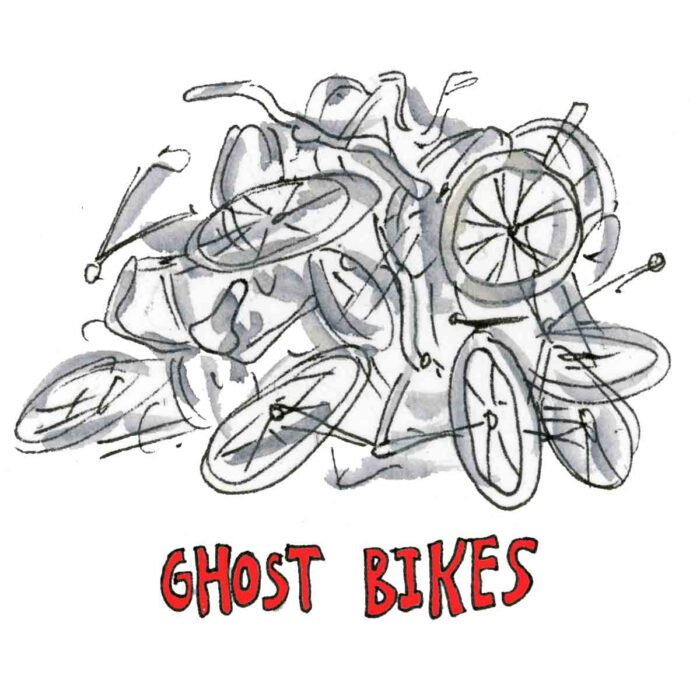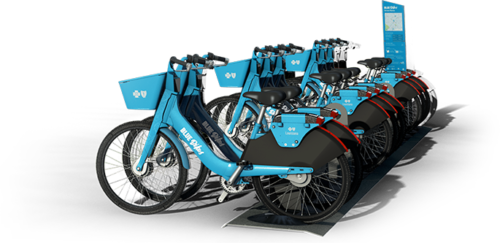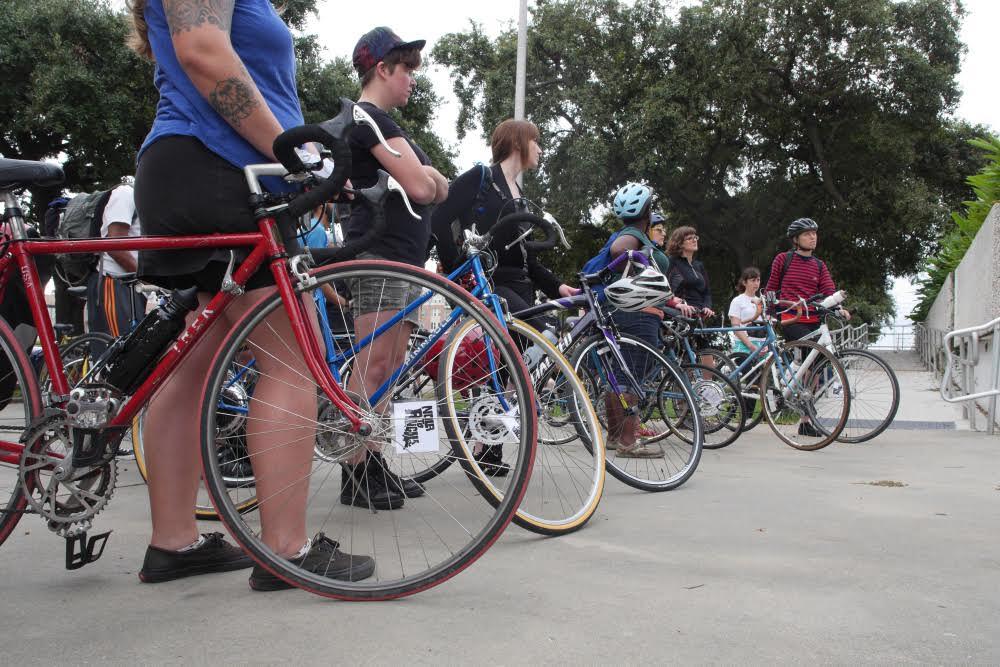It’s March, so we are marching into solutions. Yes, we’re aware of how lame that pun is! We also think it’s lame that a lot of journalism likes to describe everything that’s wrong with the world without showing data-driven examples of solutions that work! We don’t accept that, so this month we are marching (oof, there it is again) into solutions. We’ll be taking issues/problems from the Nola community and doing the research to find solutions that have proven to work! It’s solution journalism, and we’re continuing with bike safety. Those running New Orleans repeatedly let bikers be injured and killed without making effective implementations to create safe biking, and it’s not difficult…

Ghost Bikes (Illustration by: Emma Fick)
Part I: The issue
On July 6 of 2015, Ben Gregory was killed on his bicycle when he was struck by a car in Baton Rouge (Costantini). In his memory, a ghost bike memorial was placed, marking the spot where he was killed while riding. These white bicycles can be found across the nation, providing roadside memories in the location of loss, which are emerging as “contemporary mourning ritual or tradition” (Costantini). This phenomena is blurring the lines between public and private spaces of grief, and drastically calling attention to the tragic deaths occurring in distinct locations.
In New Orleans, the lack of protection for cyclists is ending in too many unnecessary deaths. I can recall one of my professors telling the class, more than once, about how he was hit by a car cycling to campus, managing to get away with a few bruises and cuts. According to Leigh, a survivor of a New Orleans bike crash, claimed that “bike lanes are not set up correctly, they’re setting up traps for cyclists who think this is a safe place to be because cars disregard them and there are no physical barriers.” Charlie Schully reported that “every cyclist I’ve spoken to, or almost all have suffered assault, harassment or physical injury.”
Cities like New Orleans depend on public transportation to gain access to necessary aspects in life, such as commuting to their job or obtaining food. But, those who continue to be disappointed most are “the people in poorer neighborhoods, those without cars, and those who rely on transit for their geographic and social mobility.” A thirty minute commute by transit only reaches 12% of the city, demonstrating how this issue dramatically lessens the opportunities for jobs and education for those who do not have a car. After Hurricane Katrina, the city “already had a very big population that was reliant on public transit and/or bicycles and it was never really acknowledged.” Public transportation was then put on hold due to the severe damage of the storm.
As New Orleans continues to develop and people move to more affordable suburbs, the commute times are only inflating. Considering that “about 20 percent of New Orleans households don’t have access to a car,” it’s determined that “those households tend to be in poorer, largely black neighborhoods.” The problem of transportation access is disproportionately affecting the large Black population in New Orleans. In the city, “5% of non-Hispanic whites lacked auto access… [and] 27% of African Americans in the New Orleans area lacked access to a car, compared to 19% of blacks nationwide” (Berube and Raphael, 1).
Amongst the crashes between motorists and bicyclists on the busy thoroughfare separating the Central Business District and the French Quarter, there are frequent hit-and-runs which in turn make the “deaths feel invisible.” According to NOLA.com, “New Orleans ranks close to the worst in the nation for walking and bicycling safety” with a “lack of effective ways to get you to and from your bus or streetcar stop.” In a study comparing Bywater with Navarre, Bywater had a 50% lower income than Navarre and had 95% more bike commuters in their neighborhood in addition to having less transit lines. Also, 18.4% of households in Bywater compared to 2.1% in Navarre are without cars. Thus, the necessity to bike out of financial constraint is a reason why those in Bywater bike more consistently.
In Louisiana, the CDC reported the leading causes of death in 2017 to include heart disease, cancer, accidents, chronic lower respiratory disease, and stroke. In examining the top five causes, the numbers totaled well over 30,000 deaths. If the next 6-10 causes are taken into account, this yields a total of almost 37,000 fatalities. The COVID-19 pandemic has only added to this toll, representing 134 deaths per 100,000 residents in the Orleans Parish. When divided by race, 19.7% of those who perished were White and 76.8% were African-American; as Black residents were dying at a rate about four times higher than Whites. Thus, those in poverty and in certain racial environments are being disregarded across contexts. The unsafe biking conditions that are affecting the poorer communities due to constraints and lack of options, blend into the disproportionate tolls of black deaths.
But, this problem does not have to persist if acknowledged as a pressing issue in the community. Efforts to transcend this matter have been attempted by Complete Streets. This organization aims to build streets which are “safe for people biking, walking, taking transit, and driving.” Their work focuses on providing viable transport alternatives to reduce traffic and parking demand. They emphasize changes such as reduced travel speeds, well-maintained sidewalks, biking paths, and accessible public transit. Their efforts for those who bike would create “spaces for riding and low speed limits, making for a safe comfortable riding experience.” As select efforts have improved the space, it’s not enough to solve the issue in its entirety. Thus, alternative models must be examined to help communities successfully cultivate cities with safe and effective options for cyclists.

Blue Bikes can get you rolling for $15 a month (Photo: https://bluebikesnola.com/)
Part II: The solution
The Netherlands and Denmark are two distinct locations in Europe which have effectively promoted safe cycling. In Europe, the “oil crisis in 1973 demonstrated that motorized transport is vulnerable,” so the Dutch government funded construction and evaluation projects for bicycling infrastructure (Schepers, 404). When the scarcity of oil limited automobile use, the shift from motorized vehicles to bicycles began to relieve traffic problems, congestion, and environmental issues. Now, the Netherlands is recognized as the world-leader in bicycle use and safety, with an “80% reduction in the number of cyclists killed per billion bicycle kilometers over a thirty year period” (Goeverden, 264). The Netherlands has become a well-known model for other countries for guidance on how to grow cycling.
The flat terrain, mild climate and high quality infrastructure make the Netherlands an ideal location for bicycling. To establish this achievement, street hierarchy was created to differentiate speed, direction and mass between higher order roads like freeways, and lower order roads to provide access to destinations. Education in schools such as the “road safety education program targeting Dutch primary school children has been in place since 1932, and became obligatory in 1959” (Goeverden, 268). Traffic rules and testing of cycling skills on public roads were examined to make sure younger children understood road safety. The infrastructure consisted of shifting vehicles away from where there is a lot of cycling, implementing bike lanes, and special tunnels under main roads. Since the 1960s, “the kilometres of roadway has doubled, however bicycle paths have increased sixfold, to 35,000 km in 2013” (Goeverden, 269). Even with an increase in roadway, the extensive bike path surge has accounted for the significant percentage reduction of deaths in the Netherlands. As “over 80% of police-reported fatal and severe BMV crashes in built-up areas…on distributor roads where exposure to high-speed motor vehicles is greatest,” the physical separation has led to reduced collisions (Goeverden, 269).
Even though the number of cyclist and automobile accidents has significantly decreased, there has been a shift from “cyclist-motorist accidents to cyclist-cyclist accidents, cyclist-pedestrian accidents, and single cyclist accidents” (Schepers, 409). But, since “accidents where no motorized vehicle is involved are generally less harmful, one could say that the objective safety improved” (Schepers, 409). Another constraint is the need for enforcing bicycle lights at night, as the “risk of collision with a motor vehicle is much higher in darkness than in daylight” (Goeverden, 270). But, the study found that “street design plays a rather limited role in the decision to ride a bike” (Goeverden, 411). Still, the use of bicycle lights and ample street lighting would considerably increase safety.
Similarly, Havana Cuba’s response to the oil crisis in the 1990s also led to increased bicycle culture. During the Special Period, Castro bought “1,000,000 bikes from China and sold them to Cubans for low prices.” In a short film narrated by Angel, a bike riding Habanero, he details the surge of biking in Havana and its importance. Amidst the oil crisis, motor vehicle use diminished and “there was no transport, there was nothing, just bikes.” The bikes were used virtually for everything, such as “taxis, to carry fruits, to sell flowers… bikes have been adapted for all transport needs.” In face of economic disaster and limited options, Cubans employed bicycle use out of scarcity and dire need. Their response illustrates how Cubans have a resourceful culture, turning pedaling into a norm on the island.
In order for Cuba to encourage cycling, they produced “campaigns, speeches, and awareness events.” As a result, “47% of Havana households owned at least one bike.. and by 1993, biking made up to 30% of trips in Havana.” This led to significant positive results, as it “increased the health of citizens” as well as “lessened the footprint that Havana leaves on the environment.” Along with these benefits, bicycling only acted as a temporary solution for their situation. When oil returned, automobile access increased again, and now “new bikes are difficult to come by and parts are not readily available” even though “many Cubans still use bikes daily.” Once the transportation crisis lessened, the practicality of bikes diminished. The resourcefulness that Havana portrayed in a time of need was unprecedented, as the city relied on bikes for transportation, jobs, and income. This was a remarkable coping strategy, but its lack of sustainability thereafter limits this model.

The NOLA to Angola Bike Ride
Applying the Solution(s) to the New Orleans Issue:
As New Orleans is currently the number one city to receive infrastructure funding, the money should be allocated to create safe streets for both bicyclists and automobiles. As of recently, President Joe Biden is distributing to the mayor, Mitch Landrieu, a “$1.2 trillion federal infrastructure bill” with $550 billion set aside for state infrastructure to oversee the distribution of one of the largest U.S. investments in “roads, bridges, broadband and other infrastructure projects in decades.” As Landrieu understands firsthand how Hurricane Katrina has caused lasting impacts, this investment will give the city an opportunity to improve their transportation.
New Orleans should utilize the already existing platform, Complete Streets, to promote the urgency of this problem. By donating funding towards this organization, the residents would be more aware of high bicycling deaths and the urgency of the issue. As the Havana population was able to utilize their resourcefulness to appoint bicycles as their mode of transportation, New Orleans communities could likewise connect each other to support cycling in the city.
After knowledge is well-circulated, then infrastructure issues may be addressed. First, the inadequate street lighting should be remedied by spending a portion of the federal funding towards placing sufficient street lighting to ensure the safety of all transit users. In New York, which is only about 48 miles² less than New Orleans, in 2013 began a “$76.5 million project” that replaced “streetlights in waves of 80,000” along with saving “$14 million in maintenance and energy annually” with LED lights. Moreover, reinforcing and providing individual bike lights would further ensure safety on darker streets. Whereas the Netherlands’ terrain and quality infrastructure aided in the implementation of bike routes, New Orleans must utilize a large amount of the budget towards fixing the potholes, sinkholes and cracks to maximize flatter terrain. This would cost at least “$5 billion,” plus another $35 million to maintain the streets annually. If they allocated enough money, time, and effort to repair the uneven streets first, implementing bike-specific infrastructure would be more attainable.
As the next step, the federal investment should be used towards implementing bicycle routes across the city. Some practical options are physical barriers between cyclists and automobiles, as well as construction of bridges and tunnels under main roads to allow further protection for cyclists in New Orleans. Since the roads are currently congested with drivers, parked cars, and streetcars, opting for alternative bike routes and encouraging drivers not to utilize certain streets would minimize cyclist-vehicle deaths as well as expand cycling access across the city. In addition, New Orleans could develop their own public bike share system like BLUEbikes in Boston to assure quick and effective cycling in the city. This would allow for affordable, reasonable bicycling with improved access to numerous destinations.
Within poorer communities and households without cars, the push towards installing safe bike routes across the city would be extremely beneficial. Not only would communities have transport besides unreliable buses and streetcars, but their safety and well-being would be greatly enhanced. As observed from Dutch and Cuban cultures, a combined solution for New Orleans leveraging the infrastructure bill would be efficient in fostering a city with significantly lower cyclist deaths, promoting environmentally-friendliness, contribute to individual health, and furthering neighborhoods’ access to the greater New Orleans. The implementation of aforementioned options would allow the city to launch a forthcoming functional solution to ensure cyclist security citywide.
Works Cited
“Another Ghost Bike Marks Another Bicycling Life Lost on N.O. Roads.” Wwltv.Com, 10 Nov. 2019, https://www.wwltv.com/article/news/local/orleans/another-ghost-bike-marks-another-bicycling-life-lost-on-no-roads/289-a490e7a6-c9c2-4c37-bfc6-a60884a5b0e6.
Bahr, Emilie S. Cycling in the Crescent City: An Exploration of the Spatial Variation in Bicycle Commuting in New Orleans, https://scholarworks.uno.edu/cgi/viewcontent.cgi?article=2659&context=td.
“Bluebikes: Metro-Boston’s Bikeshare Program.” Blue Bikes Boston, http://www.bluebikes.com.
Complete Streets – Bike Easy. https://bikeeasy.org/our-work/advocacy/complete-streets/. Accessed 14 Dec. 2021.
Costantini, Nicole M. “Bikes and Bodies: Ghost Bike Memorials as Performances of Mourning, Warning, and Protest.” Text and Performance Quarterly, vol. 39, no. 1, Jan. 2019, pp. 22–36. https://doi.org/10.1080/10462937.2019.1576919.
Coyula, Miguel. “Havana: A Bike-Friendly City?” MEDICC Review, vol. 18, Medical Education Cooperation with Cuba, July 2016, pp. 40–40. SciELO, https://doi.org/10.1590/MEDICC.2016.18300013.
“Cyclists Keep Getting Killed. Can New Orleans Keep Them Safe?” Grist, 9 Sept. 2019, https://grist.org/article/cyclists-keep-getting-killed-can-new-orleans-keep-them-safe/.
Dorrier, Jason. “New York City to Replace 250,000 Street Lights With LEDs by 2017.”
Singularity Hub, 10 Nov. 2013,
https://singularityhub.com/2013/11/10/new-york-city-to-replace-250000-street-lights-wit
Former New Orleans Mayor to Head up Infrastructure Project | Biloxi Sun Herald. https://www.sunherald.com/news/politics-government/article255829976.html.
Goeverden, Kees, et al. “Interventions in Bicycle Infrastructure, Lessons from Dutch and Danish Cases.” Transportation Research Procedia, vol. 10, Jan. 2015, pp. 403–12. ScienceDirect, https://doi.org/10.1016/j.trpro.2015.09.090.
Multimedia, Kauri. Havana Bikes. 2014. Vimeo, https://vimeo.com/89544788.
“New Orleans Needs to Fill the Gaps in Its Transit System.” NOLA.Com, https://www.nola.com/opinions/article_052013d1-ab24-5d78-aa61-4ee0efcc7c0f.html.
Schepers, P., et al. “The Dutch Road to a High Level of Cycling Safety.” Safety Science, vol. 92, Feb. 2017, pp. 264–73. ScienceDirect, https://doi.org/10.1016/j.ssci.2015.06.005.
Stats of the State of Louisiana. 24 May 2019,
https://www.cdc.gov/nchs/pressroom/states/louisiana/louisiana.htm.
Times-Picayune, Kevin Litten, NOLA com |. The. “New Orleans Needs $5 Billion to Repair
Crumbling Streets, More for Maintenance.” NOLA.Com,
https://www.nola.com/news/politics/article_9d575801-3cd1-55be-b800-b3a7d10ff369.
html.
“Transportation.” Havana Special Period, 26 Apr. 2012, https://havanaspecialperiod.wordpress.com/transportation/.
Weinstein, Rachel, and Allison Plyer. “Detailed Data Sheds New Light on Racial Disparities in
COVID-19 Deaths.” The Data Center, 25 June 2020, https://www.datacenterresearch.org/reports_analysis/lack-of-data-obscures-true-levels-of-racial-inequity-in-covid-deaths/.
What Went Wrong with New Orleans Transit? https://www.politico.com/agenda/story/2018/11/20/new-orleans-public-transportation-000796/.
 NOLAbeings Multimedia artist Claire Bangser created NOLAbeings as a portrait-based story project that marries...
NOLAbeings Multimedia artist Claire Bangser created NOLAbeings as a portrait-based story project that marries...  Voodoo in New Orleans: Reviving history: New Orleans fortune telling This article takes a deep dive into the history of Voodoo in New Orleans, its hybridization with Catholicism, and its present-day place in the city's culture. The author visits fortune-tellers in the French Quarter, using their guidance as a tool for introspection rather than a deterministic predictor of the future. Through her experiences in New Orleans, the author feels a mystical connection to both the past and the future.
Voodoo in New Orleans: Reviving history: New Orleans fortune telling This article takes a deep dive into the history of Voodoo in New Orleans, its hybridization with Catholicism, and its present-day place in the city's culture. The author visits fortune-tellers in the French Quarter, using their guidance as a tool for introspection rather than a deterministic predictor of the future. Through her experiences in New Orleans, the author feels a mystical connection to both the past and the future. 